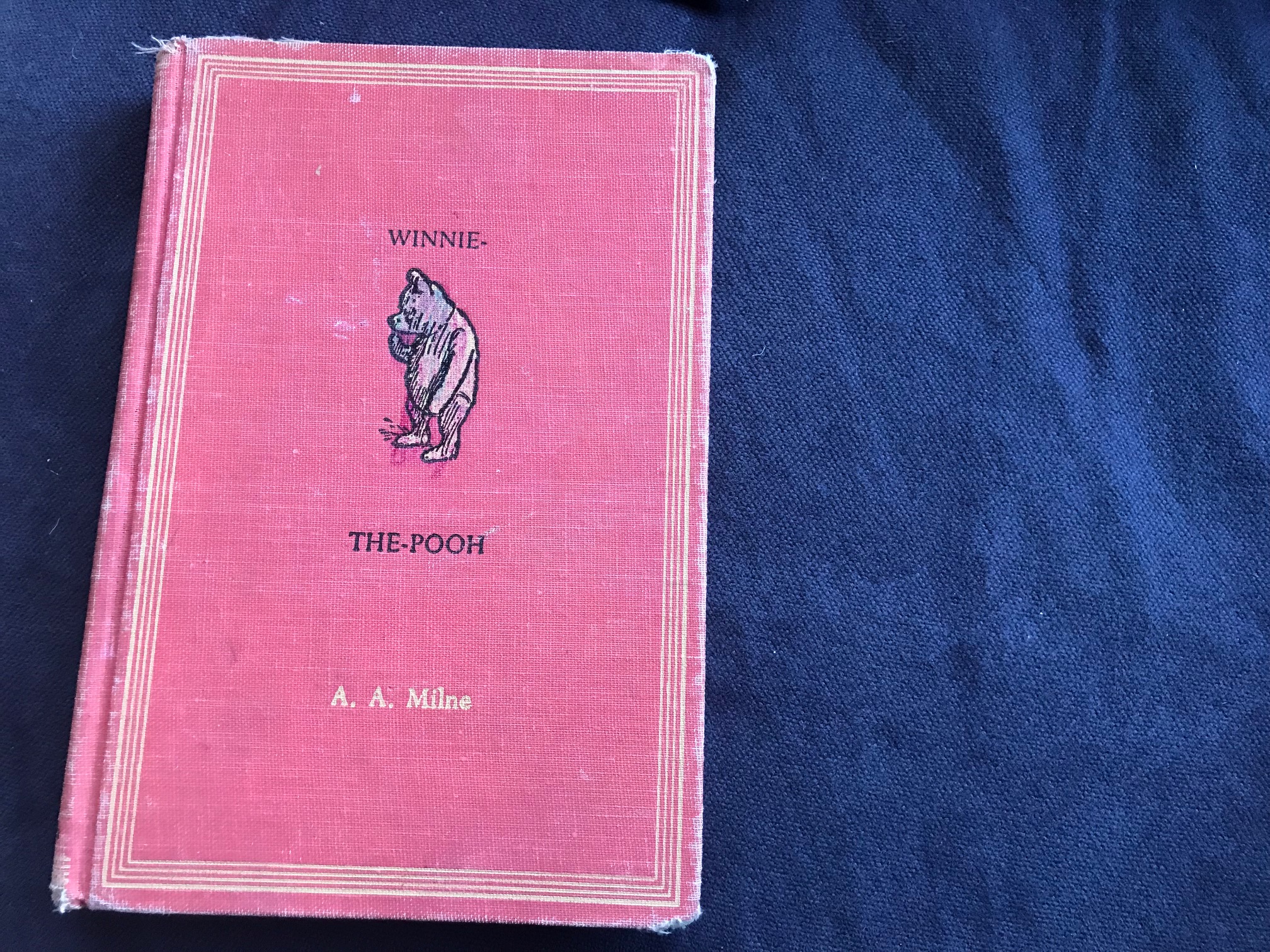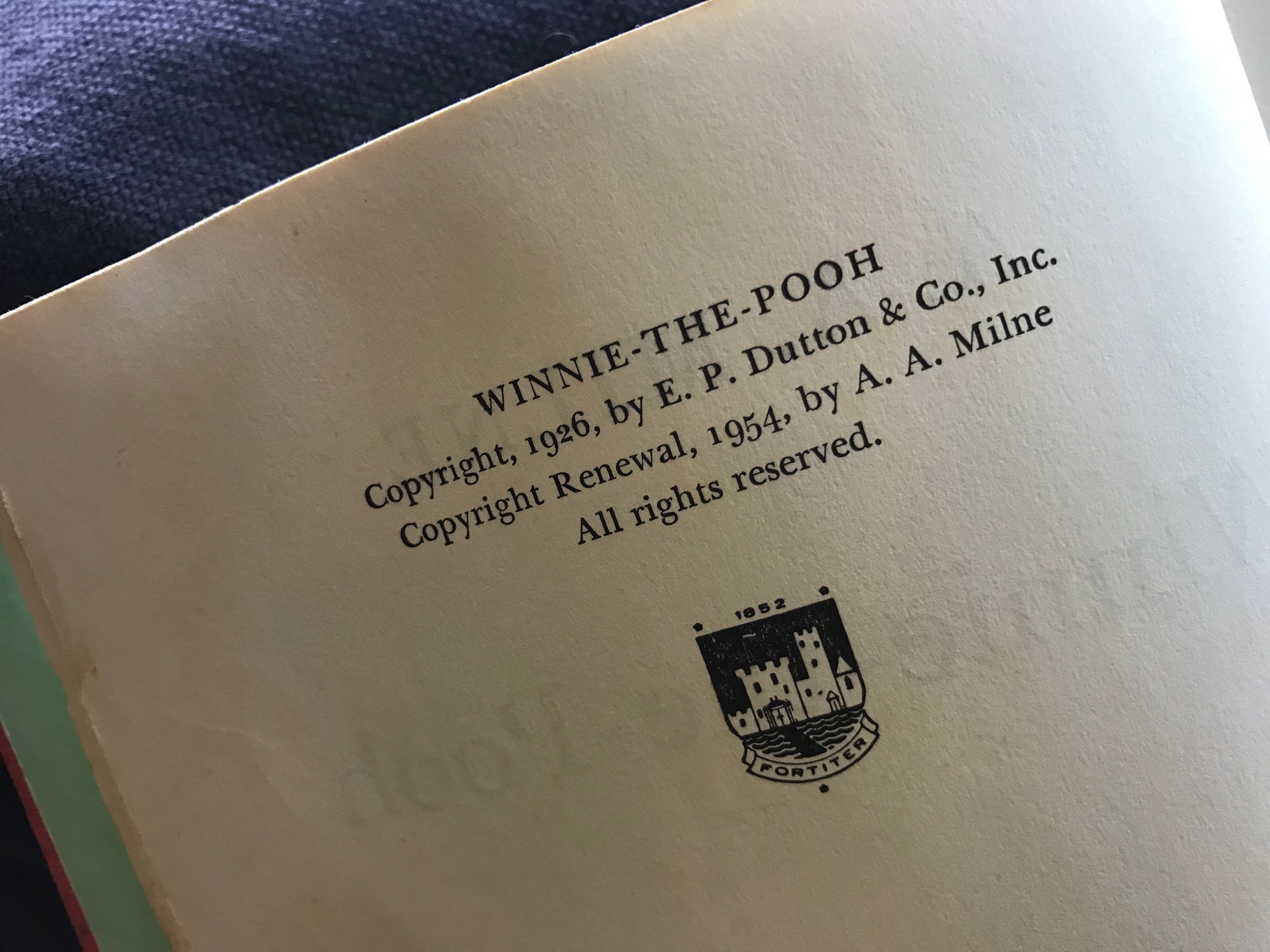Vintage Winnie The Pooh Book, 1954 Cloth Cover: 3,999 ppm Lead (90 is unsafe) + 326 ppm Arsenic!
Yes, vintage books can have lead! This 1954 Reprint of the 1926 children’s book “Winnie The Pooh” tested positive for both Lead and Arsenic in the cover art.
When tested with an XRF instrument the book pictured had the following levels:
- Lead (Pb): 3,999 +/- 94 parts per million (ppm)
- Arsenic (As): 326 +/- 59 ppm.
This is the highest lead level I have ever found in testing a vintage book.
In my experience, most vintage books come in at a lead (Pb) level in the 200 to 400 ppm range.
See more vintage books I have tested here.
For context, the amount of lead that is considered unsafe in a modern item intended for use by children and manufactured today is anything 90 ppm or higher in the coating and anything 100 ppm or higher in the substrate. This book is therefore on my “very unsafe” list, especially since it is a painted coating on the cover and it is frequently handled by children. The interior pages also tested positive for lead at about 22 parts per million (+/- 6.) The book (both the cover and the pages) were negative for mercury (Hg) and cadmium (Cd.)
Safer Choice: Get a new copy! The words and the sentiment are the same and it will have been printed with child-safe inks! (Something you can confidently pass on to your grandchildren!)
Here is an affiliate link to a new copy of this book on Amazon! If you purchase anything using one of my affiliate links I will receive a small percentage of what you spend at no extra cost to you! Thank you!
If you appreciate this information, please help protect future generations of children by sharing this post!
Thank you!
Thank you for reading and for sharing my posts.
As always, please let me know if you have any questions!
Never Miss an Important Article Again!
Join our Email List






Who knew?! Thankfully I only opened this a handful of times and my kids were too little to hold it themselves to read. thank you!!
Dang it. We are book lovers, and especially vintage book lovers, and my little children adore our old copies of Milne’s Pooh classics. They are beautiful little books that hold a special place for us, as our 5 yo grew up with these bedtime stories, even ‘reading’ them to herself before she could speak sentences. Planned on sharing them with our newest little one too. …but I just ran to take them off their bookshelves. Really worried about how they may have affected my children, and also really sad to lose the books.
So, Questions-
1. The matching set we have also came with original book jackets that were covered in modern clear plastic (like libraries use) to protect the old paper jackets. We removed the jackets long ago, but I have them still, and they are still in plastic covers. Do you think it would be ok to use these plastic covered book jackets, and still let the children use these covered books like that?
2. Do you still have access to this^ book? We have this same one, but the matching ones from the set have different dates at the top of that page (52, 56, etc), while they all say printed 1961 at the bottom of the page you show (your photo doesn’t show the bottom, but I assume it’s also a 1961 printing like ours says). Any reason to think the others would be safe though? Wishful thinking. Probably should assume the whole set is toxic…
3. We also have this one that’s a little different, but super similar
( https://i.etsystatic.com/5879983/r/il/935a48/1892587075/il_570xN.1892587075_5il9.jpg ). It was printed a few years earlier, ’55, and has a green plastic-y coating cover instead of painted cloth. Do you know how bad that would be, comparatively?
4. For Christmas we bought them these two, 100yr old children’s books (color-coated fabric hardbacks) –
https://images-na.ssl-images-amazon.com/images/I/51SAOEg51TL.jpg
https://i.ebayimg.com/images/g/OH0AAOSwGrFZggwo/s-l1600.jpg – because they seemed special and we thought they’d like them later.
Should I assume they’re equally dangerous? Will all vintage, colored cloth hardbacks be dangerous? Do we need to stop collecting beloved antique books?
(I’m a holistic-minded momma that is dedicated to a healthy, natural lifestyle for my family!)
5. When it comes to the dangerous substances in these kinds of books, if we touch them (like I just did, flipping to find their published dates), is it effective to just wash our hands after? What about just wiping them off with a napkin (or my pants, ha)? Or, on contact, does it like, immediately go into my body and stay there??
Thank you so so much for all the work you do to help families, and for your willingness to answer questions, etc. You are so appreciated!
Thank you! Traveling – 1:00 a.m. gotta sleep. will respond Sunday or Monday!
– Tamara
Hi Tamara,
I am interested in your responses to Krystal Wight Armstrong, because I also have a collection of antique books. Would washing hands, or plastic jackets eliminate the danger of owning these?
I have a newly-acquired set of Tupperware clear plastic turquoise stem ware (for wine) -safe for patio use- which were never been used by my parents, who received them as a gift around 1996-99. Would they be safe to use occasionally? Maybe for water, which is less acidic?
Mine also says “Reprinted September 1961” and it has a different logo image than your photo does. I’m interested in your reply to Krystal.
Hi Megan – check out the overview post on vintage books – which is broken out by decades. Similar style of books from similar decades will (in most cases) have similar lead levels:
https://tamararubin.com/2020/04/this-post-has-all-of-the-links-to-my-posts-about-books-vintage-new-paperback-hardcover-comics-more/
This post also discusses the concern in greater depth:
https://tamararubin.com/2020/01/folks-have-been-asking-if-lead-in-vintage-books-is-a-real-poisoning-concern-click-to-read-my-response-here/
Tamara
I believe I have this book. We had the 2 book set in my home when I was a child, and I’m pretty sure I got them from my mom.
I am also curious to read the answers to the above questions.
Hi Tamara,
I also have this as part of a 4 book set that belonged to my brother as a child and who has now passed on, it’s the only thing I have of his to remember him by; I have a copy of Little Women with blue cloth covering but I cannot find a date on it anywhere this belonged to my Aunt; and a copy of Black Beauty printed in 1938 with a brown, beige and green cover with flowers and other characters (15 items in total) on the cover – it doesn’t feel like cloth per se but does have a textured feeling to it – it belonged to my Father. It’s funny but I was just planning on wrapping these all up with a few other items to mark as a “KEEP” item for my son to keep and pass along to future Generations after I am gone and was going to label it all in the tote with information that I know about each item…..and then I stumbled upon your site.
I was looking into all at the posts about Corelle & Pyrex and went looking for the “to toss or not to toss page” and saw the Winnie the Pooh book and was very saddened by it.
How, how do you pass on the only history items you have from people that are loved and long gone knowing that those items are detrimental to our health?? And how do / can I find out if those other books have the same levels of contaminates?
I just spent the last 1/2 hour looking through them and now have a headache….. psychosomatic or from breathing in while looking at them??, and how do we know how clean our hands are after touching these items, how many times do I have to wash my hands before I can safely touch my face, pet my cat or prepare and eat a meal?? OMG…..the rabbit holes this can take a person down!!
I also have a small black (not cloth, but textured) prayer book that belonged to my Great, Great Grandmother which was printed anywhere between the early 1890’s to 1920 what are your thoughts on that? Lead? Arsenic? Wow! What a sad day for a book loving family! I do have pictures if you think that would be of any help.
Thank you,
April M. M.
Hi Tamara, I’m wondering, with some of these older books, if the high lead is not solely from the inks, but also from offsetting or leaching of metal from hand-set foundry type into the ink. Have you tested contemporary letterpress printed items? I was a letterpress printer for many years and handled a lot of metal materials, type, spacers, leading, etc. most of which contain a substantial quantity of lead. I had my blood tested for lead when I ran the press and never had elevated levels but I do wonder now if lead ever had the potential to migrate into the items we printed via the few seconds that ink sat in the type between prints. We were taught in school to be aware of lead hygiene in regards to washing hands thoroughly after handling type before eating, etc., but were never warned about the potential for toxicity in the prints themselves. Most contemporary letterpress printers use photopolymer and not hand-set type, but there are many of us that still have and maintain the antique equipment. Wondering if the printing process itself imparts lead into the paper or if it’s the inks that were/are used that were/are the main source of the problem. Thanks!